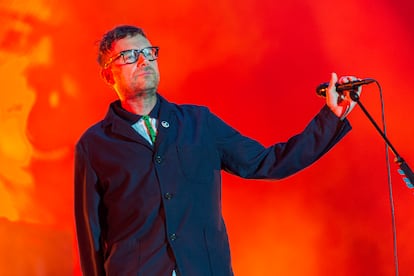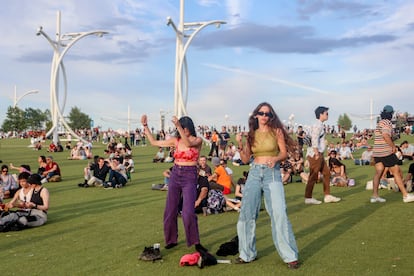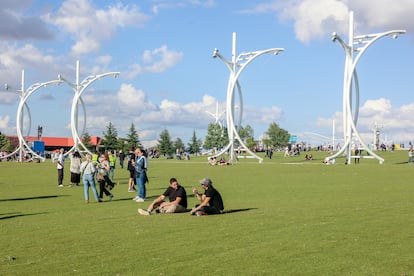How old is too old to attend a music festival?
Judging by the lineups of the most recent festivals, which include an array of veteran artists that triumphed 30 or 40 years ago, it is clear that festivals are for everyone, regardless of age

Have you ever felt old as they put the wristband on you at the entrance of a music festival? If you have, don’t let it get to you: these events are actually meant for people like you. “Ultimately, festivals are for older people, because that is the generation that invented them and, in fact, the one that programs the lineup. Festivals are a way for us to feel younger: they are the natural form of entertainment for mature people,” says Gerardo Cartón, author of Así se baila el siglo XX (This is how you dance the 20th century). “That’s why the lineups bet on bands that were already big in the 1990s. They are targeting that audience that has purchasing power thanks to their age, and can spend money on a festival without worrying about the price of the tickets or even VIP tickets, which for more money offer a more comfortable experience, with fewer lines and which, in the end, is worth it for many.”
Máximo Lario, director of the Bella Festival in Marbella, Spain, explains that some names are on the lineup precisely to foster a more transversal audience, both in age and in musical tastes. “The fact that we continue to have considerable demand in the older age group is significant: 26.3% of the attendees are between 35 and 45 years old and 20.3% are between 45 and 54 years old. Young people between the ages of 18 and 24 account for just over 10%,” he says. Marc Tapias, the press officer of Barcelona’s Festival Cruïlla, explains that 37% of attendees are men over 40 and 25% are women in the same age group. “We take our audience very much into account when we work on the lineup; in fact, one of the things we are most proud of is the transversality of the proposal, which allows different generations to enjoy the festival. Placebo is a very good example: their fans include an older audience, but in recent years they have been able to attract new audiences,” he says.
Rosa Fernández, director of musical client management at ticketing company DICE Spain, explains that many of these attendees are among those they refer to as the early birds; those who purchase tickets — usually at a lower price — when the lineup has not yet been announced. “Big festivals are massive, and their goal is to sell tickets to a large number of attendees; in this sense, the lineup seeks to please diverse audiences and attract different generations. The intention is to retain the regulars and the adult audience, yes, but also to gain new audiences,” she explains.

Miriam Mateu, founder of Festival de Lazareto in Menorca, Spain, explains that her event targets people between 28 and 45 years of age. “Our festival is premium, we select iconic artists that people of a certain age like, but the good thing is that 25-year-olds are also responding very well. For example, last year the top seller was Kool & the Gang, a band that was successful especially in the 1970s, and their concert was full of people between 25 and 35 years old.” Mateu also mentions a detail that, although apparently inconsequential, defines the type of audience that Lazareto is after: at the festival, drinks are served in glasses, not plastic cups. “This already segments the type of audience,” she explains.
Not just music
Many veterans will remember a time when the fanciest thing to eat at a festival was a taco. However, it is increasingly common for music festivals not only to boast a solid lineup, but also a premium gastronomic offer. This year, the second edition of Lazareto features five-Michelin-star Chef Paco Pérez, who designed a tasting menu that will be served in the festival restaurant before the concert. It costs €75 ($82) and consists of seven dishes. “Right now, festivals are having a lot of success not only because of the musical performances, but because of the experience that is built around them. I think what’s interesting is how the premium audience and the younger one share the same space,” says Mateu. “Some may go to watch the sunset, have a snack and stay for a few drinks, but then some go to the Michelin restaurant to later see a concert and have a drink on the terrace, as if they were in the bar of a luxury hotel. What divides the different age groups are those extras that complement the performance,” explains the founder.
Marc Tapias points out that since the percentage of the audience over 40 years of age is close to 35%, Cruïlla makes a special effort to offer a more comfortable experience for them. “This includes different gastronomic options that fit all budgets, but always keeping in mind that in Cruïlla you can eat well at reasonable prices and comfortably,” he adds.

However, some still prefer the tried-and-true classics: a hot dog and a beer in a plastic cup. “I say a resounding NO to snobbish festivals,” says Araceli Segura, a 48-year-old graphic designer, festival veteran and former member of a short-lived band called Les Biscuits Salés. “I don’t want to go there and find a sort of adult playground. When you go to a festival, you know what to expect: if you need to rest, you sit on the ground. Rest areas with sponsored couches make me cringe. I couldn’t care less about gastronomy at a festival. I would appreciate a squeaky clean bathroom, but that’s impossible. What I value the most is that everything can be heard well, something that I suppose has to do with my age, but I think that it is what must be demanded of a festival.”
Hugo García, 49, head of communication for the Moby Dick Club in Madrid, admits that time has made him more particular and discriminating with festivals, valuing things that he did not pay attention to before. “In the first editions of the FIB [Festival Internacional de Benicàssim] of the mid-1990s, you didn’t care about where to sleep, what to eat, how to shower… Now you make sure that the venue is clean, that there’s some space to rest and that it’s comfortable. As my blood pressure is low, I appreciate that there is coffee, which is something unusual. I also appreciate that there is wine, because I fill up with beer. This may all sound like nonsense, but it shapes the entire festival experience. In the case of Primavera Sound in Madrid, for example, after seeing how long it would have taken to get there and back, I just didn’t go,” he explains.
For Máximo Lario from the Bella Festival, although there is a correlation between the purchasing power of each age group and consumption, there are many surprises in this regard. “It’s not always true that the older a person is, the higher the purchasing power and consumption will be,” he points out.
But then... are we too old to go to festivals or not? Who doesn’t remember being 20 and throwing suspicious glances at the 40-year-old man who is next to you dancing to the same band? “The first festival I went to was the Phoenix Festival in 1993, in the U.K., and it was full of older people. I guess they have more of a musical tradition there, and people of all ages attended. That also happens at Coachella; it may seem that the audience is made up of brainless influencers, but then you go and there are many grandparents, like veteran showbiz people from Los Angeles watching their classic bands in the sun,” remembers Araceli Segura. So, if you feel old when you go to your next festival this summer, it may be because you are — but you are not alone: festivals are made for you. It is them, the young ones, who are the anomaly. At least in that audience.
Sign up for our weekly newsletter to get more English-language news coverage from EL PAÍS USA Edition
Tu suscripción se está usando en otro dispositivo
¿Quieres añadir otro usuario a tu suscripción?
Si continúas leyendo en este dispositivo, no se podrá leer en el otro.
FlechaTu suscripción se está usando en otro dispositivo y solo puedes acceder a EL PAÍS desde un dispositivo a la vez.
Si quieres compartir tu cuenta, cambia tu suscripción a la modalidad Premium, así podrás añadir otro usuario. Cada uno accederá con su propia cuenta de email, lo que os permitirá personalizar vuestra experiencia en EL PAÍS.
¿Tienes una suscripción de empresa? Accede aquí para contratar más cuentas.
En el caso de no saber quién está usando tu cuenta, te recomendamos cambiar tu contraseña aquí.
Si decides continuar compartiendo tu cuenta, este mensaje se mostrará en tu dispositivo y en el de la otra persona que está usando tu cuenta de forma indefinida, afectando a tu experiencia de lectura. Puedes consultar aquí los términos y condiciones de la suscripción digital.
More information

How to date in the Tinder era when you’re over 40

Neither sex nor children: Couples today are most concerned about money
Últimas noticias
There is as much life left to discover on planet Earth as that which is already known
Dozens presumed dead, around 100 injured in fire at Swiss Alps bar during New Year’s celebration
Is porn for women different from conventional porn? We spoke to those who make it
Cartagena de Indias is sinking: What can the city do to mitigate it?
Most viewed
- Reinhard Genzel, Nobel laureate in physics: ‘One-minute videos will never give you the truth’
- David King, chemist: ‘There are scientists studying how to cool the planet; nobody should stop these experiments from happening’
- Sinaloa Cartel war is taking its toll on Los Chapitos
- Oona Chaplin: ‘I told James Cameron that I was living in a treehouse and starting a permaculture project with a friend’
- The Interoceanic Train, the Mexican alternative to the Panama Canal








































